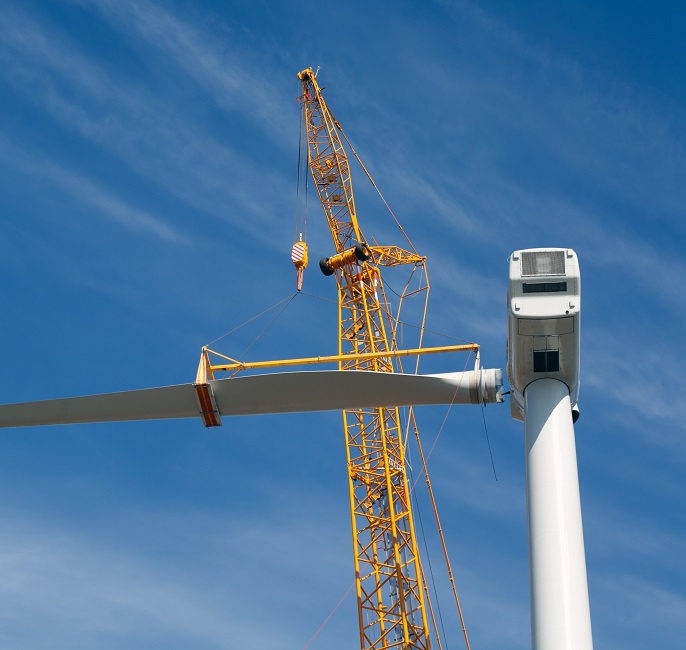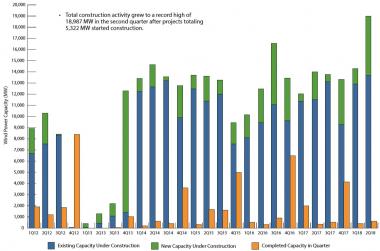US wind hits highest-ever build activity; Annual PPA record broken in August
Our pick of the latest wind power news you need to know.

Related Articles
US wind construction activity hits record high
Some 5.3 GW of new U.S. wind farm projects started construction during the second quarter of 2018, bringing total wind construction activity to a record level of 19.0 GW, the American Wind Energy Association (AWEA) said.
An additional 3.9 GW of new U.S. wind power capacity entered advanced development, bringing the total capacity in this phase to 18.8 GW, AWEA said. In the advanced development phase, projects have achieved a major milestone such as placing a turbine order or procuring a power purchaser, meaning they are likely to begin construction in the near-term.
Current U.S. wind activity is being supported by production tax credits (PTCs) which are being scaled down annually.
Extended in 2016, the PTC scheme provides ten years of tax credits. The level of support drops by 20% annually with zero support from 2020. This means projects started in 2018 can capture $13.8/MWh of credits.
The tax credit support has boosted wind repowering activity, as well as greenfield projects.
Of the 37.8 GW of wind capacity under construction or in advanced development, 31% was in the Midwest region while Texas hosted 21% of activity, followed by 19% in Mountain West, 19% in the Plains states and 10% in other regions.
The U.S. installed 626 MW wind capacity in Q2, raising total installed wind capacity to over 90 GW.
US wind quarterly construction activity
(Click image to enlarge)
Source: American Wind Energy Association (AWEA)
In January, the U.S. Energy Information Administration (EIA) predicted installed wind capacity will rise by 8.3 GW in 2018 and push annual wind generation above hydroelectric output for the first time.
Installed wind capacity is expected to rise by a further 8.0 GW in 2019, EIA said in its Annual Energy Outlook.
US sets new annual renewables PPA record in August
The U.S. has signed 3.6 GW of corporate wind and solar power purchase agreements (PPAs), breaking the annual record in less than eight months, the Rocky Mountain Institute's Business Renewables Center (BRC) announced August 8.
The previous record was set in 2015, when 3.1 GW of corporate PPAs were signed. Some 2.9 GW was contracted in 2017, according to BRC data.
Since 2008, some 13.5 GW of corporate renewables PPAs have been signed in the U.S.
In July, Facebook signed the largest purchase deal, a 437 MW solar power contract with Pacific Power in Oregon.
Facing rising power demand from data centers, global technology groups have spearheaded growth in corporate PPAs. Energy-hungry tech giants are pioneering multi-buyer power purchase agreements and demand from other industries is growing fast.
US corporate renewable PPA deals
(Click image to enlarge)
Source: Business Renewables Centre (BRC), August 2018.
Europe has lagged behind U.S. on corporate PPA growth but European Union directives, growing demand from heavy industry, and global contract innovations should see PPA growth rise towards U.S. levels in the coming years.
Demand for renewables PPAs is also set to accelerate in Middle East and North Africa, following a shift away from fossil fuel subsidies, regional experts said.
AEP cancels 2 GW Wind Catcher project after Texas rejects
American Electric Power has cancelled a project to build a 2 GW windfarm and 350-mile transmission line in the U.S. Interior after the Public Utility Commission of Texas denied approval of the project.
The Wind Catcher project involved the development of the U.S.'s largest wind farm in the Oklahoma Panhandle and construction of a transmission line to send the power to eastern Oklahoma. The project also proposed to serve customers in Texas, Louisiana and Arkansas.
In late July, the Public Utility Commission of Texas rejected the project, saying it did not provide enough benefits for ratepayers. Oklahoma authorities had already questioned the benefit to consumers and were yet to make a final decision. The project had gained approval from federal, Louisiana and Arkansas authorities.
“We are disappointed that we will not be able to move forward with Wind Catcher, which was a great opportunity to provide more clean energy, lower electricity costs and a more diverse energy resource mix for our customers in Arkansas, Louisiana, Oklahoma and Texas,” Nicholas Akins, AEP chairman, president and chief executive officer, said in a statement.
“To realize the full benefits of Wind Catcher for customers, timely approvals were required from all jurisdictions so we could complete the project by the end of 2020 and be eligible for 100% federal production tax credit," Akins said.
New Energy Update

